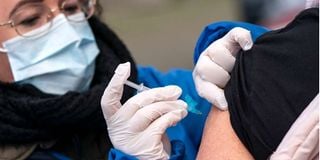Premium
How to ensure vaccine will be available to all

A high risk patient receives an influenza vaccine.
What you need to know:
- Estimates suggest that vaccination levels of 60-70 per cent are needed to achieve the minimum requirement for herd immunity
- Kenya’s top sectors such as Agriculture, Manufacturing, and Tourism are contact-intensive
First things first: How to distribute the vaccines
What will be required to immunise Kenyans who need or want the vaccine? Well, it depends. The specific vaccines the Ministry of Health will decide on notwithstanding, this is the time to take stock of what we are really doing to ensure that the vaccine will be available not just in Kenya, but in the right place at the right time and in the right quantities for those who need it.
Around the globe, many of the low and middle income countries are going through the COVAX facility — a partnership of the World Health Organization, Gavi and Coalition for Epidemic Preparedness Innovations — to secure subsidised vaccines for their people.
The challenge with COVAX is the relatively low volumes available to each of the countries that have signed on because the initial focus will be on 3 per cent of the population. So, if Kenya does nothing but apply to COVAX, we will only get vaccines for health workers and people with underlying conditions, progressively increasing to 16-20 per cent as more vaccines become available.
Vaccination levels
Estimates suggest that vaccination levels of 60-70 per cent are needed to achieve the minimum requirement for herd immunity —-the level at which most people are protected against a virus.
A number of both developed and developing countries are moving to negotiate directly with vaccine manufacturers to secure additional supplies under bilateral arrangements, whose funding is expected to come from development agencies including the Africa Export Import Bank, the World Bank and other Development Financing Institutions under the Advance Market Commitment arrangements.
As Health CS Mutahi Kagwe aptly warned, "If we continue to behave normally, this disease will treat us abnormally." This warning should not be limited to observing the Covid-19 protocols put in place. It should include preparedness for accessing and efficiently administering the vaccine. Therefore, we have to raise our game and look beyond COVAX.
Kenya’s top sectors such as Agriculture, Manufacturing, and Tourism are contact-intensive. Our hospitality industry has borne the brunt of Covid restrictions, with many people losing their livelihoods. As the government proposes to reopen schools on January 4, we also need a plan to protect teachers as well as parents, especially the older ones and those with underlying conditions.
Following studies at the summer camps in the US state of Georgia and our recent experience with Covid-19 in schools that have been closed after reopening, we now know that while they appear to be mostly asymptomatic, children are super spreaders.
A cost benefit analysis is integral to our approach to determining who we target, where we source the vaccines from, and how soon we lock-in our options.




